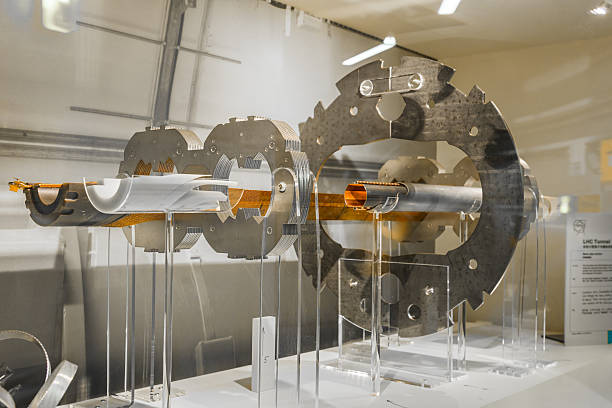The Large Hadron Collider Explained
Published on 11 Oct 2023
Physics
The Large Hadron Collider (LHC) is the world's largest and most powerful particle accelerator, consisting of a 27-kilometer ring of superconducting magnets with accelerating structures to boost the energy of particles. It is located on the French-Swiss border near the European Organization for Nuclear Research (CERN) headquarters. Despite its recent invention, the Large Hadron Collider remains one of the most significant inventions in history.
The Collider itself is a particle accelerator, designed to accelerate two particle beams to collide. These collisions are used as a research tool to make discoveries about the behavior of particles. There are several colliders in the world, including two in Russia, one in Japan, one in Italy, one in China, one in the US, and the Large Hadron Collider on the French-Swiss border, which happens to be the largest particle collider and the biggest scientific experiment in the world.

The history of the Large Hadron Collider is noteworthy. It was launched on September 10, 2008, after a decade of construction, costing around 7.5 billion euros. Some scientists and environmentalists had speculated that the LHC might create a mini black hole capable of destroying the Earth. However, these claims were refuted by CERN and renowned physicist Stephen Hawking, who stated that any mini black holes would evaporate instantly. The LHC is operated by CERN, which consists of 23 European countries.
While the LHC was built to observe the behavior of particles, its primary purpose is to create and discover the Higgs boson, famously known as the "God particle."

The Large Hadron Collider (LHC) is a massive scientific device constructed underground near Geneva, Switzerland, built to investigate the fundamental mysteries of the cosmos. It is made of a 17-mile circular tunnel lined with powerful superconducting magnets, through which subatomic particles are pushed to near light speed and collide. These collisions produce extremely high energy densities, simulating circumstances in the early cosmos, shortly after the Big Bang. Scientists capture and examine the debris from these collisions using detectors such as ATLAS and CMS, discovering new particles and interactions. The LHC has been critical in furthering our understanding of particle physics, confirming the existence of the Higgs boson and probing questions concerning dark matter.

To learn more about the building blocks of matter and the forces that control the universe, researchers are using the LHC to conduct experiments. Scientists can investigate the ensuing interactions and watch how particles behave under severe circumstances by fusing particles together at very high energies. The search for new particles outside of those found in the Standard Model of particle physics is one of the LHC's primary objectives. An important milestone was reached at the LHC in 2012 with the identification of the Higgs boson, the particle that gives other particles mass. Since then, scientists have been looking into more conceivable particles that might shed light on the mysteries of the cosmos, such as supersymmetric particles and dark matter candidates. The largest of the projects, ATLAS and CMS, employ all-purpose detectors to examine the broadest spectrum of physics imaginable. For cross-confirmation of any new discoveries made, two separately built detectors are essential. Detectors for focusing on particular phenomena are available in ALICE and LHCb. These four detectors are located on the LHC ring underground in sizable caverns.

The Large Hadron Collider is considered to be the strongest particle accelerator in the world. Use of strong electric and magnetic fields allows boosting the likelihood of collisions of particles. The reason behind the impressive size of the LHC is its ring-like structure consisting of magnets and accelerating components, which is about 27 kilometers long. The introduction of the LHC allowed nuclear physicists to expand their understanding of the wondrous nature of fundamental particles and led to a number of significant discoveries. One of the prominent examples is the discovery of a mediator particle called the Higgs boson, which is produced by excitation. Mediator particles are conducting force: for example, photons carry electromagnetic force. According to electroweak theory, mediator particles have no mass; however, with the help of the LHC, physicists refuted this prediction in a series of experiments in 2012. This discovery led to a breakthrough in research into phenomena occurring in the universe. Another discovery made using the LHC has an origin that traces back to the 1960s when two scientists were investigating subatomic particles affected by strong force, and their constituents: George Zweig and Murray Gell-Mann. The latter one named these constituents as quarks and classified them into 3 types; after a while, scientists discovered another 3 types of quarks. Later in the 2000s, research used the LHC to identify several other types of quarks, which are predicted to transform understanding of the traditional model of quark structures.
In a nutshell, the Large Hadron Collider serves as a shining example of how collaborative scientific endeavors can bring us remarkable results. It's propelled us deep into the intricate world of particle physics. With its colossal size and groundbreaking discoveries, the LHC firmly etches its place as a historic landmark in the annals of science, constantly broadening our comprehension of the cosmos and the fundamental building blocks that define it.